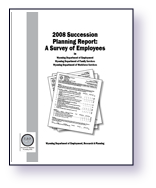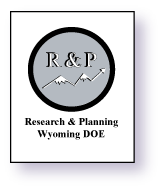Chapter 7: Occupations of Concern
by: Dr. Mark A. Harris, Sociologist
The purpose of this chapter is to identify occupations of potential concern, where a relatively large component of incumbents have indicated an intent to leave or retire within the near future. Such information may be useful to department managers to plan for succession or to take steps to retain existing incumbents. This analysis was made possible by combining the succession planning survey data previously collected and described in the methodology chapter with administrative data available to Research & Planning (R&P) that contains occupational information on all state employees.
Data
Data used for this section include Unemployment Insurance (UI) wage records for Wyoming state government employees provided to R&P each quarter by the Wyoming State Auditor’s Office. The Auditor’s Office file includes the Wyoming Department of Administration and Information: Human Resources Division (A&I: HRD) specified job title for each state employee (e.g., FS01-D or Financial/Statistical Specialist 01-Economist). For use here, the state job title was converted to an associated six-digit Standard Occupational Classification (SOC) code.1 This crosswalk process involves A&I: HRD staff and the Wyoming analyst responsible for the Bureau of Labor Statistics’ Occupational Employment Statistics program. The cross walk is periodically revised as state job titles change. As an example, the state job title FS01-A or Financial/Statistical Specialist 01- Auditors corresponds to SOC 13-2011 Accountants & Auditors. A six-digit SOC code for each employee was then matched to the corresponding employee information in the succession planning survey data gathered under this study. Appendix E, Table 1 shows the occupational distribution for state employees and the breakdown of SOC occupations by the three agencies under study: the Department of Family Services, Department of Employment, and Department of Workforce Services. Complete job descriptions of the six-digit SOC codes can be found at (http://doe.state.wy.us/LMI/EDSPubto20081ECI/TOC000.htm).
Confidentiality Issues
R&P is not authorized to disclose the identity of any individual state employee or their responses to any of the questions on the succession planning survey. Knowing, for example, that Barry is the only accountant in a department means that if R&P were to disclose the retirement intentions for the one accountant in the department, we have de facto revealed Barry’s identity as well as Barry’s retirement intentions. We do not disclose any information if there is a risk that the identity of an individual or their response to any survey question will be revealed.
Department of Family Services
Table 1 shows the SOC code for DFS employees who were in the master survey file.2 The table shows the number and percentage of incumbents in each occupation who stated an intent to retire or leave the department in less than five years. Occupations with a relatively high percentage (30.0% or higher) who indicated an intent to leave or retire in less than five years include managers, all other (30.0%), training & development specialists (33.3%), management analysts (38.5%), and accountants & auditors (35.5%). Occupations with a relatively large absolute number (10 or more incumbents) not mentioned previously included child, family, & social workers (n = 33), social and human service assistants (n = 21), and eligibility interviewers, government programs (n = 32). Overall, 148 DFS survey respondents (20.0%) indicated that they intend to leave or retire from the department in less than five years.
Department of Employment
Table 2 shows the SOC code for DOE employees who were in the master survey file. Occupations with a relatively high percentage (30.0% or more) who indicated an intent to leave or retire from the department in less than five years included general & operations managers (42.9%), managers, all other (50.0%), registered nurses (54.5%), occupational health & safety specialists (40.0%), and construction & building inspectors (80.0%). Occupations with a relatively large absolute number (10 or more incumbents) not mentioned previously included eligibility interviewers, government programs (n = 16). Other occupations worth mentioning for DOE included accountants & auditors (9 or 24.3%). Overall, 70 DOE survey respondents (23.4%) indicated that they intend to leave or retire from the department in less than five years.
Department of Workforce Services
Table 3 shows the SOC code for DWS employees who were in the master survey file. Occupations with a relatively high percentage (30.0% or more) who indicated an intention to leave or retire from the department in less than five years included human resources managers (42.9%), managers, all other (33.3%), employment, recruitment, & placement specialists (38.6%), and health educators (37.5%). Other worthwhile mentions for DWS just shy of the specified criteria included rehabilitation counselors (6, or 17.1%). Overall, 60 DWS survey respondents (25.3%) indicated that they intend to leave or retire from the department in less than five years.
Observations
Management positions may be a concern for all agencies as well as accountants & auditors in both DFS and DOE. Possible programs aimed at providing managerial training for first-line or mid-level supervisors may be warranted. There also appears to be a concern in regard to bread-and-butter positions within each of the departments. Eligibility interviewers in DOE, social workers in DFS, and employment specialists in DWS may be of concern for turnover. Although largely beyond the control of individual agencies, improved pay structure and advancement opportunities as well as more flexible work arrangements may be helpful in attracting new employees and in retaining seasoned employees within these core departmental occupations.
The next chapter of this publication will discuss the plans for working after formal retirement among survey respondents. This includes an assessment of the reported factors that potentially enhance the likelihood of returning to work.
1. This crosswalk process facilitates the use of OES estimates in the creation of market wage rates (see http://doe.state.wy.us/lmi/oes.htm for complete OES data for Wyoming). (Return to Text)
2. Respondents who indicated that they had already formally retired were excluded from this portion of the analysis. (Return to Text)

